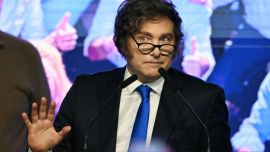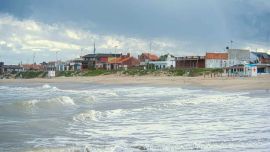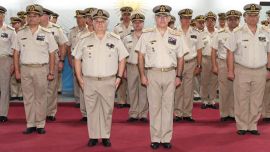Tuesday’s inauguration has too much national significance to continue the ongoing series on trouble-spots elsewhere in the region, which has served its purpose in filling the transition between the elections and the new government. But cutting short this series also means returning to an earlier theme – the provincial profiles in the first half of the year. Because “national significance” will be understood here in a wider and more federal sense than the central government to which it is invariably linked – here we will ignore next Tuesday’s proceedings in Congress to look at the inaugurations around the rest of the country.
As from next week provincial administrations will be headed by old and new faces in almost equal measure, despite the general impression of this year’s local elections being one long procession of triumphs for incumbent governments with just a couple of significant exceptions such as Santa Fe and (of course) Buenos Aires Province. Indeed, the old faces outnumber the new by only 13-11 among local chieftains and we could even create a majority for the latter if we subtract from the former City Mayor Horacio Rodríguez Larreta (on the grounds that he is not a provincial governor) plus three-term Governor Gerardo Zamora of Santiago del Estero and Gustavo Valdés of Corrientes (both of Radical origin on opposite sides of the political divide, curiously enough) for whom any new inauguration will depend on a future election – both terms end two Decembers from now with their electoral timetables disrupted in both cases by previous federal trusteeships. These two provinces will take no further part in this survey.
At the top of the country Jujuy’s Radical Gerardo Morales is the only re-elected governor aligned with outgoing President Mauricio Macri (even if he was the leading opponent of Radical entry into Cambiemos in 2015) – his 2015 vote of 58 percent, achieved by making indigenous leader Milagro Sala his target rather than his official Peronist rival gave him sufficient cushion to absorb the loss of 15 points from this year’s anti-Macri trend (more fortunate than his Bolivian namesake across the border).
The other re-elected governors loosely qualify as Peronists (or neo-Peronists) of one sort or another but they range from such a bitter foe of Kirchnernism as Córdoba’s Juan Schiaretti to a member of the Kirchner family. Embarking on his third term, Schiaretti is a law unto himself – heading a Peronist landslide of over a million votes (57 percent) last May in a province which voted 61 percent for Macri six weeks ago. Polarisation and his own health problems with multiple stents make it unlikely that he will project his own brand of moderate “republican” Peronism beyond Córdoba.
Of the three re-elected Patagonian governors, only Alicia Kirchner of Santa Cruz is Kircherite by definition – although her recent policies such as freezing provincial pay over three years (broken only by a 40 percent hike in mid-2018) seem closer to Macri than her sister-in-law and make her re-election last August (with 23 percent of the vote but augmented to 59 percent by her two Peronist rivals) seem almost as miraculous as her achievement of a balanced budget this year.
Omar Gutiérrez of the Neuquén Popular Movement (MPN) and Mariano Arcioni of Chubut Somos Todos represent provincial parties but both with Peronist roots – the MPN was founded in 1961 as a neo-Peronist party to bypass the 1955-73 ban on the movement itself, winning every election since, while Arcioni served as lieutenant-governor under Mario Das Neves, a Peronist close to ex-president Eduardo Duhalde, succeeding him at his death in 2017. Gutiérrez generally saw Macri as a safer bet for his beloved Vaca Muerte shale but has adapted quickly to the future government, while Arcioni’s main local rival is Kirchnerism but he blames Macri for this year’s acute insolvency crisis.
The other five re-elected governors are more typically Peronist. Gustavo Bordet of Entre Ríos (who will start his second term on Wednesday) and San Juan’s Sergio Uñac are mainstream Peronists who know how to run their provinces – both garnered 56-57 percent of the vote last June. But not in the same league as San Luis Governor Alberto Rodríguez Saá, about to be inaugurated for his fourth term after fighting off the challenges of his predecessor Claudio Poggi and his five-term brother Adolfo – the same surname for 30 of the years since 1983 in San Luis. But the ultimate dinosaur is Formosa’s Gildo Insfrán, starting his seventh term on Tuesday after sweeping 71 percent of the vote. Juan Luis Manzur’s grip on Tucumán has undoubtedly been cemented by the sex scandal hitting his three-term predecessor Senator José Alperovich but his aspirations to head the league of governors by cosying up to Alberto Fernández have lost ground in the last month.
Of the 11 new governors, only four represent a change of government. No less than 14 governors sought re-election but two were frustrated by the Supreme Court (La Rioja’s Sergio Casas and Río Negro’s Alberto Weretilneck, both elected lieutenant-governors in 2011, were denied a third consecutive presence on a gubernatorial ticket) while the other two were at the wrong end of a change of government (both women, María Eugenia Vidal and Rosana Bertone in BA Province and Tierra del Fuego respectively). Casas alienated almost all fellowPeronists in La Rioja with his re-election bid, finally settling on a former three-term provincial capital mayor Ricardo Quintela as his successor, while on Monday, previous tourism minister Arabella Carreras will become Río Negro’s first woman governor (one of only two female victors this year, both Patagonian).
Of the four changes of government, only the return of Buenos Aires and Santa Fe provinces (over 45 percent of the total electorate together) to their traditional Peronism from centre-right and centre-left administrations respectively was clear-cut. Salta’s politics are basically Peronist infighting with both outgoing moderate Peronist three-term governor Juan Manuel Urtubey and provincial capital mayor Gustavo Sáenz (Sergio Massa’s 2015 running-mate) opposed to Kirchnerism. Both candidates in Tierra del Fuego were Kirchnerite but Bertone made concessions to Macri’s austerity and lost to Radical ‘K’ Río Grande Mayor Gustavo Melella, who on December 17 will become Argentina’s first openly gay governor.
The only provinces where re-election is not a constitutional option are Santa Fe and Mendoza (which stayed Radical with provincial capital mayor Rodolfo Suárez winning by over 15 points with an absolute majority), thus still leaving four provinces where re-election was neither sought nor defeated – Catamarca, Chaco, La Pampa and Misiones.
In Misiones Hugo Passalacqua (also elected lieutenant-governor in 2011) respected the ban on a third candidacy, unlike Casas and Weretilneck, and backed his lieutenant-governor Oscar Herrera Ahuad, who swept 73 percent of the vote. Fighting cancer, La Pampa Governor Carlos Verna made way for his ex-minister and current deputy Sergio Ziliotto, who held eternally Peronist La Pampa with an absolute majority. Catamarca Governor Lucia Corpacci’s motives for stepping back are less clear but she preferred to move to Congress, leaving the province to yet another provincial capital mayor, Raúl Jalil, who gained promotion to governor with over 60 percent of the vote. Chaco was the least amiable transfer with former Cabinet chief Jorge Capitanich basically bullying Governor Domingo Peppo into giving him a third gubernatorial term.
No room left for the Santa Fe’s highly moderate Peronist new
governor Omar Perotti nor for two men who might well become
president – Rodríguez Larreta, now virtual opposition leader, and
Buenos Aires Province governor-elect Axel Kicillof (Cristina
Kirchner’s ‘Plan B’ after her son Máximo to be the next president,
provided that he can handle the politics and sociology of Greater
Buenos Aires). But then they should need no introduction.related news





















Comments